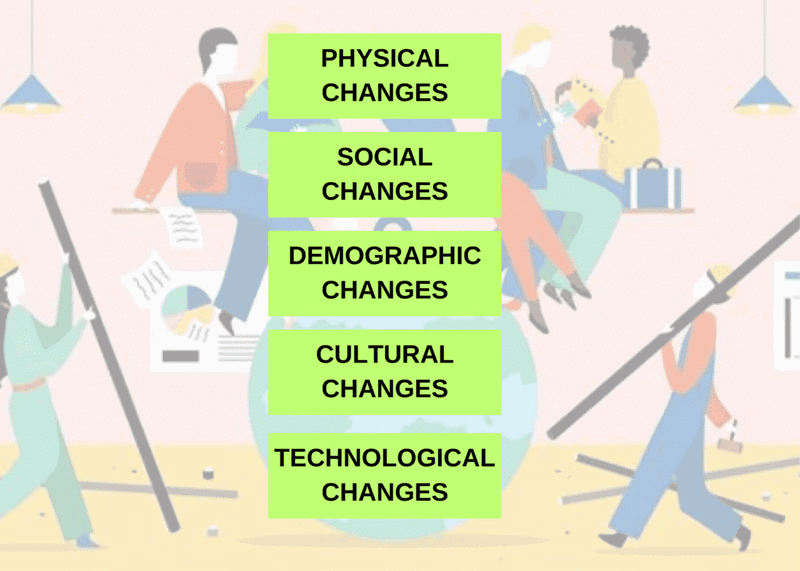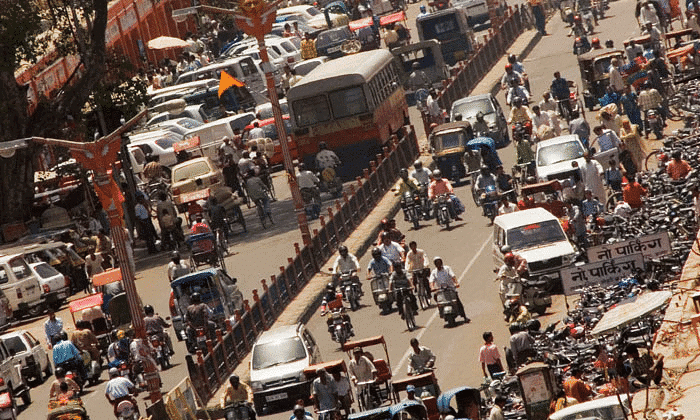NCERT Summary: Social Change and Social Order in Rural and Urban Society (Class 11) | Old & New NCERTs for IAS Preparation (Must Read) - UPSC PDF Download
In today's ever-evolving and modern society, ongoing change is a constant aspect of our society.
Social Change
- Change is the most enduring feature of any society, and social change refers to the transformation of people's attitudes and behaviour.
- Social change occurs due to a variety of factors, such as physical, social, demographic, cultural, and technological changes.
- These changes occur over time and create differences between various social structures, ultimately leading to modifications in human institutions, relationships, patterns, processes, systems, and so on.
 Factors Affecting Social Change
Factors Affecting Social Change
Types of Changes
1.Internal Change
An internal change is when the ideals and values of a particular period significantly differ from those of the preceding age.
2. External changes or structural change
- When there is a change in the structures and foundations of any aspect of society, such as family, marriage, kinship, class, caste, or groupings, it is known as an external change.
- Social change is a comprehensive term that encompasses all aspects of society, including the political, cultural, economic, and physical spheres. Environmental, technological, economic, political, and cultural factors are considered the main drivers of societal change.
- Changes in structure can be used to explain social change.
- Structural change refers to alterations in the institutions that constitute a society or in the rules that govern these institutions. For example, the introduction of paper currency brought about a significant shift in the organization of financial markets and transactions.
3. Endogenous and Exogenous change
- Some sociologists have differentiated between endogenous change, which originates from within a society, and exogenous change, which comes from outside of it.
- It could be contended that conflicts and conquests, which are exogenous factors, have played a crucial role in the significant societal changes that have taken place in communities worldwide.
4. Evolutionary Change
Evolution refers to the gradual development from a less sophisticated state to a more intricate and sophisticated one.
Charles Darwin's Theory of Evolution
- Darwin proposed that all living beings begin in a simple state.
- Over a period of many years or even millennia, humans have evolved gradually by adapting to their environment.
- Darwin's theory emphasises the idea of "survival of the fittest," in which only organisms capable of adapting to their surroundings are able to survive, while those who cannot adapt or do so too slowly eventually perish.
- Darwin's theory illustrates natural processes.
5. Radical change
- Rapid or sudden change, often with political implications, occurs when a previous governing class is overthrown. Examples include the French Revolution, Industrial Revolution, and Communication Revolution.
- Values and beliefs have undergone change: in the late 19th century, it was believed that children should begin working as soon as possible, as seen in the prevalence of child labor.
- The early manufacturing system relied on the labor of children as young as five or six years old. However, child labor was officially banned in many countries in the 20th century.
- While some industries in our country still rely to some extent on labor, such as carpet weaving, small tea shops, restaurants, and matchmaking, child labor is prohibited, and owners can be prosecuted as offenders.
Environment
- The impact of the environment on social change is significant, as physical surroundings can stimulate societal change that cannot be stopped or resisted by humans.
- Environmental changes can affect society in two ways: natural disasters can have irreversible destructive effects, while environmental discoveries can lead to new job opportunities and social change.
- The geographical conditions of the natural world can fundamentally alter society, and these changes are often permanent and irreversible, preventing a return to their previous state.
Technology and Economy
- The term "technology" refers to advanced tools and techniques used to achieve material objectives.
- Technology not only affects the material world but also impacts relationships and the natural environment. It helps us adapt to the challenges posed by nature, as demonstrated by Japan's expertise in electronics and technology despite its hilly and cold terrain.
- The industrial revolution brought significant social change to nearly every society in the world.
- Various technological advancements such as gunpowder, paper, transportation, railways, and aviation have had a profound impact on society.
- While technological changes can be a catalyst for social change, as seen in the industrial revolution, societal transformation can also arise from non-technological shifts in the economic system, as exemplified by the abolition of the slave trade between the 17th and 19th centuries.
- Sometimes changes in economic organisation that are not directly technological can also change society.
Politics
- Social change has been attributed to political power, with power shifts resulting from political changes causing social transformation in society.
- In many instances throughout world history, the first responsibility of a country after winning a war was to rebuild its social structure.
- Political changes resulting from conflicts between nations or kingdoms frequently lead to social change.
- Societal transformation can result from political changes within a society, such as the rejection of the monarchy.
- During its rule, America underwent significant changes, along with Japan's industrialization and land reforms.
- Political changes are occurring not only on a global scale but also locally.
- The introduction of universal adult suffrage, granting voting rights to anyone who is at least 18 years old, has been the biggest political shift in history.
Culture
- Cultural change occurs when there is a shift in an individual's behavior or actions.
- Religion can have a significant impact on socio-cultural institutions. As religious beliefs and norms play a vital role in shaping society, any change in these norms can contribute to the transformation of society.
- Religious ideas and norms can influence society's organization, similar to how the bhakti movement impacted the social structure of medieval India.
- The development of new concepts can lead to social change, as seen in the evolution of women's role in society from ancient to modern times.
- New communication technologies in rural areas have contributed to cultural progress, reducing cultural backwardness.
- Dominant castes hold power in economic, social, and political spheres. Changes in the technological system of agriculture and the use of new machinery have widened the gap between landlords and laborers, leading to changes in land ownership.
Social Order
- Social order is the structured organization of the social system.
- It helps in maintaining and promoting social relationships.
- It assists society in preventing, regulating, and managing social changes.
- Social order is necessary for the smooth functioning of society.
- Social order usually revolves around dominant groups, and they may resist any alterations that could destabilize their social standing.
To bring about social order
- Societies use a combination of methods to ensure that their rules and values are followed by members. These methods include both forced obedience and voluntary consent, and they serve to maintain social order.
- However, the dominant group often uses social order to control and govern social developments that challenge their norms and values, which can lead to oppression of other groups. The oppressed group may seek changes to benefit themselves and challenge the position of the dominant group.
- Ultimately, members of society should have the freedom to choose whether to follow the rules and values of their society.
Social control
Social control refers to the intentional maintenance and promotion of particular social patterns, values, and standards. In all societies, members are encouraged to conform to a set of norms and laws, either through various forms of coercion or through internalized pressure.
Domination, Authority and Law
- Organized groups have regular members and some with power and responsibility. Power is a synonym for sovereignty.
- Power is the ability to influence someone to act in your favor, even against their will.
- In society, there are different types of power, such as dominance, authority, and legality.
1. Dominance:
- It is a power dynamic where the parties have settled roles, and the relationship is stable and has established power.
- In normal times, the dominant group significantly impacts society, as people may do things they do not want to do without causing confrontation, similar to forced cooperation.
2. Authority:
- Max Weber defined authority as the legitimate form of power, which adheres to accepted standards of justice, appropriateness, and rightness.
- For instance, police officers, judges, and educators all exert various forms of power as part of their duties, and their authority is defined in written documents.
- This type of authority is linked to a person's official position rather than the person themselves.
- Because they hold a position of power, it follows that everyone else in the community has agreed to follow its laws.
3. Laws
- A law can be defined as a clear and specific rule or principle put into writing.
- These written regulations, which are binding on all members of a society, are typically formal and legal in nature.
- Certain laws may include specific instructions on their creation, modification, or enforcement in the event of a violation.
Contestation, Crime and Violence
1. Contestation
- It is used here as simply a word for broad forms of insistent disagreement .
- The presence of conflict and competition in a society creates an environment where behaviors that deviate from social norms can occur.Social norms can be violated in various ways, ranging from general non-conformity to more serious forms of deviance.
2. Crime
- It refers to actions that go against the accepted values and standards of a society. Those who violate social norms are typically labeled as criminals. For example, the British authorities considered breaking Gandhi's salt prohibition as a criminal offense.
- The concept of crime is exclusively rooted in the legal system. Any act that contravenes the law is considered a crime.
- Since crime is an act that disrupts the established social order and societal values, it leads to social disintegration.
 Social unrest
Social unrest
3. Violence
- It is a type of protest that goes beyond breaking the law and also undermines significant societal norms. It represents a challenge to the social order and indicates the existence of significant underlying issues, which in turn raises questions about the government's authority.
- Violence can be classified as either legal or illegal. The state has the exclusive right to use force within its jurisdiction, except in rare cases such as self-defense. All other forms of violence are considered criminal.
- The rise in crime and violence can be attributed to societal unrest in both rural and urban areas, as well as an increase in juvenile delinquency and violent behavior.
Social Order and Change in Village, Town and City
- The distinction between rural and urban settlements is based on a combination of factors, including population density, economic activities, infrastructure, and social and cultural aspects. While there are some exceptions and overlaps between the two categories, these general distinctions serve as a useful framework for understanding the differences between rural and urban ways of life.
- Villages are smaller settlements with a significant proportion of their population engaged in agricultural activities.
- On the other hand, towns and cities are larger urban settlements with more diverse economic activities and a higher population density.
- While towns and cities are similar in nature, they are differentiated by size and administrative definitions.
- An urban agglomeration refers to a city along with its surrounding suburban areas and satellite settlements, while a metropolitan area includes more than one city or a continuous urban settlement many times the size of a single city.
- Urbanisation has several causes, including industrialisation, economic development, improved transportation and communication, and an overall increase in population. It is closely tied to modernisation and industrialisation processes, as urban areas offer better access to jobs, education, healthcare, and other essential services.
- The impact of urbanisation can be both positive and negative. On the positive side, urbanisation can lead to economic growth and development, as well as an improved quality of life for many people. It can also foster innovation, creativity, and cultural exchange through the concentration of diverse populations in urban centres.
Social Order and Social Change in Rural Areas
- The unique characteristics of villages – their size, social structure, power dynamics, and cultural values – contribute to a slower pace of social change compared to urban areas.
- However, this does not mean that change is impossible in rural areas. With access to education, information, and resources, as well as the support and encouragement of progressive movements and policies, the marginalized sections in villages can gradually work towards social change and empowerment.
- The lack of anonymity and distance in villages makes it challenging for people to dissent or challenge the existing power structures. This is because they can be easily identified and suppressed by the dominant sections.
- Additionally, the scattered nature of villages and their limited connectivity to the outside world in the past has contributed to slower cultural and social changes. However, advancements in communication and transportation have improved connectivity, reducing the cultural gap between villages and towns.
- Another significant change in rural societies has been the increasing commercialization of agriculture. With the growth of urban markets and the expansion of global trade, farmers have shifted from subsistence farming to cash crop cultivation. This has led to greater integration of rural economies with national and international markets, exposing farmers to price fluctuations and market risks. In some cases, this has driven small farmers into debt and increased their vulnerability to market forces.
- The Government initiatives like MGNREGA, PMGSY have brought some relief to rural populations, but more needs to be done to address the root causes of rural distress, such as land fragmentation, lack of access to credit, poor infrastructure, and the lack of alternative livelihood opportunities.
Social Order and Social Change in Urban Areas
- Urbanism is a modern phenomenon.
- Before the modern era, trade, religion and warfare were some of the major factors that decided the location and importance of cities.
- Development of group identities has taken place based on factors like race, religion, ethnicity, caste, region, and of course class, which are all well represented in urban life.
- High density of population and large number of workers.
 High denisty of population in urban areas
High denisty of population in urban areas
- Housing problems: Shortage of housing for the poor leads to homelessness, and the phenomenon of ‘street people’, those who live and survive on the streets and footpaths, under bridges and flyovers, abandoned buildings and other empty spaces.
- It is also the leading cause for the emergence of slums. A slum is a congested, overcrowded neighbourhood with no proper civic facilities and homes made of all kinds of building materials ranging from plastic sheets and cardboard to multi-storeyed concrete structures.
- Ghettoisation: Ghettoisation is the process of creation of ghettoes through the conversion of mixed composition neighbourhoods into single community neighbourhoods. A ghetto is an area or locality that is populated largely by members of a particular community. This may occur due to various social, cultural and economic reasons.
- Increasing pollution is a major concern in urban areas.
- All modern facilities are available: water, police, security etc.
- Gated Communities: Urban localities (usually upper class ) are sealed off from its surroundings by fences, walls and gates, with controlled entry and exit.
|
3 videos|729 docs|527 tests
|
FAQs on NCERT Summary: Social Change and Social Order in Rural and Urban Society (Class 11) - Old & New NCERTs for IAS Preparation (Must Read) - UPSC
| 1. What are the main factors that contribute to social change in rural and urban societies? |  |
| 2. How does social order maintain stability in rural and urban areas? |  |
| 3. What role does modernization play in social change? |  |
| 4. Can social change lead to social conflict? How? |  |
| 5. What are the differences between social change in rural and urban settings? |  |
















